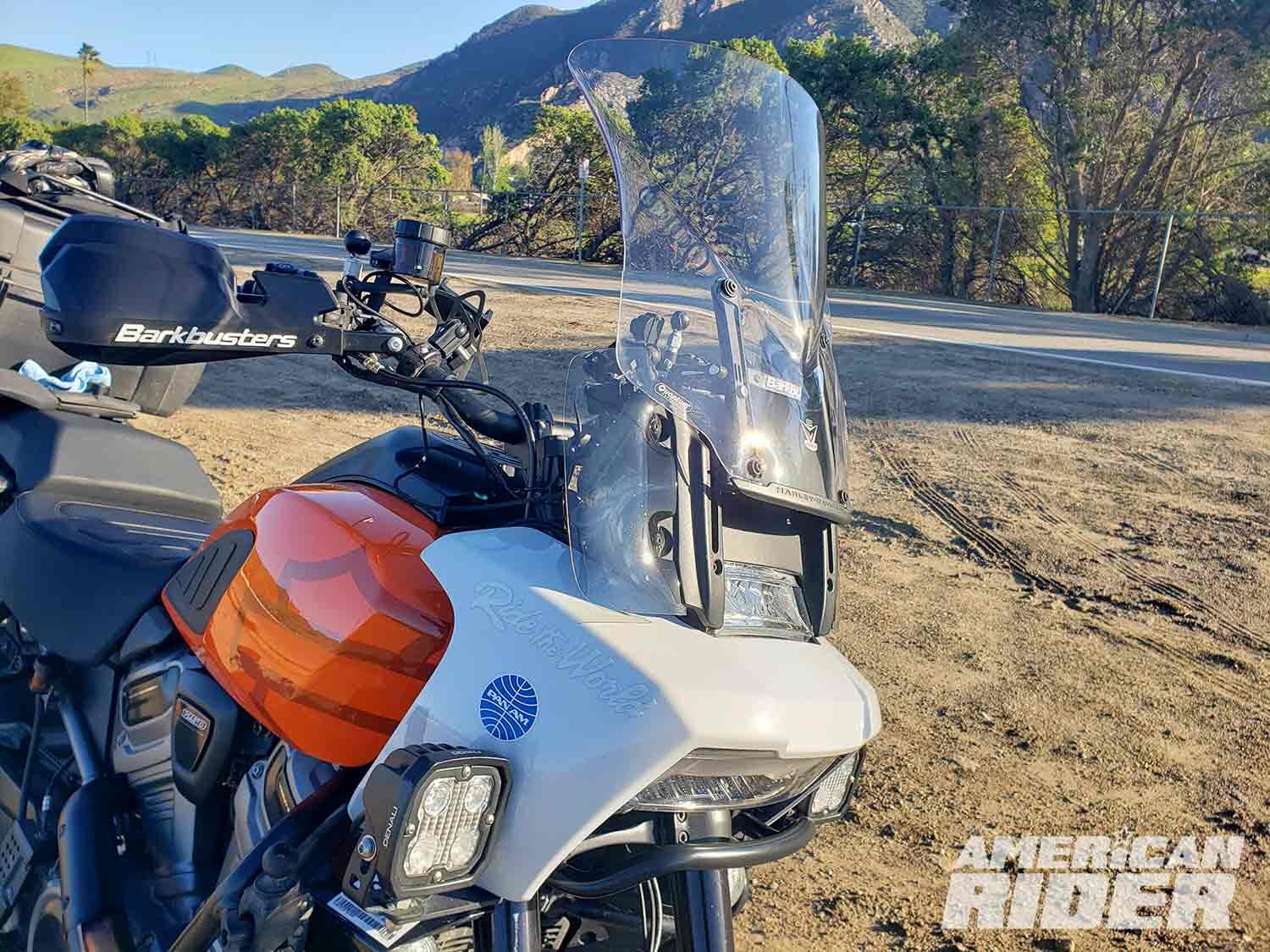Any time I get the opportunity to use new equipment on one of my motorcycles, I always evaluate it based on the additional miles I can ride comfortably in a day. For example, a bike may be good for 350 miles a day before I’m ready to park it for the night. A new seat may add 100 miles per day. A different handlebar position might improve it by 50 miles per day.

So when I had the opportunity to mount up the new National Cycle VStream windscreen on my 2021 Harley Pan America, I was excited about the potential of adding miles of comfortable riding to my adventure touring plans. I tested both the Mid and Low versions of the VStream.
See more American Rider reviews here
The National Cycle VStream is a direct bolt-on to the mounting brackets for the OEM windscreen. National Cycle includes two new clear deflectors that replace the black plastic OEM deflectors. This requires a little more work, but it still ended up being only about a 1 out of 10 on the mechanical difficulty scale.
I’ve had previous experience with National Cycle VStream windscreens on touring bikes. My current touring bike has over 41,000 miles, and the VStream windscreen has been on there for 35,000 of those miles. It remains crystal clear after rocks, bugs, and bird strikes, so it is hard stuff.
As to the Pan Am, it already has one of the best wind-management systems of any motorcycle I’ve ridden over the past 48 years, which has included Gold Wings, Voyagers, Beemers, and Harleys to name a few. Most wind-management challenges come from the air being pushed up past the fork right into the rider’s upper chest and face. That’s not an issue with the Pan Am.

The National Cycle VStream windscreen takes advantage of the Pan Am’s wind management and makes it even better. The VStream has a unique shape – hence the “V” in VStream – which forces wind up around the rider rather than into their face or onto the top of their helmet. The clear deflectors that are included in the kit are wider and taller than the OEM deflectors contributing to a laminar airflow up the back side of the windscreen.
Installation took about 20 minutes and required removing the stock windscreen as well as the black plastic deflectors. Instructions were clear and included helpful photos. With the windscreen in its most leaned-back position, it touches the new air deflectors, helping to reduce airflow coming through any gaps.
I tested both the 13.5-inch Low screen and the 16.4-inch Mid screen, using them in all three positions provided by the Pan Am’s adjustable system.
Unsurprisingly, the Low screen was less effective at diverting wind. In the lowest position, the effect of the windscreen was not noticeable at all, like riding a sportbike. In the middle and highest settings, air was directed slightly up and into the top of the faceshield on my Scorpion AT950 helmet. This contributed to a bit more “bobblehead” feeling as the turbulence created a back-and-forth effect. With the Low screen, wind noise around the helmet was noticeably louder, drowning out the sound of the Pan Am’s exhaust. At 65 mph, there was a noticeably wider air pocket that pushed the wind stream out nearly to the end of the handlebars.

The Mid screen provided a much more relaxed ride with no helmet buffeting. Wind was smoothly deflected up and over the helmet. Both National Cycle windscreens have a slight optical distortion at the point of the wind deflection grooves. While not noticeable riding down the road, you can see it when looking downward.
One of the desired effects of taller windscreens is reduced noise. I used the Soundmeter app on my phone to measure the noise level. While certainly not laboratory quality, it does provide a comparison point. The noise levels created by the windscreens at 65 mph on an asphalt road with street tires were as follows:
- Stock – 74dB
- Low Screen – 74.9dB
- Mid Screen – 73.5dB
The lower noise level of the Mid screen allowed me to lower the volume on my headset. My riding partner said there was virtually no wind noise coming through our helmet headsets, which could not be said with the stock windshield.
So, to get back to the miles-per-day metric I mentioned earlier, I would say that the National Cycle VStream Mid windscreen would provide enough protection to add another 100 miles to a day of riding. The Low screen might reduce that number by 50 miles or so.
National Cycle has been making windscreens for a long time, and it shows. Top-quality Quantum hard-coated polycarbonate materials are used to make the products, and the toughness of this material has proven itself to be one of the screens’ greatest assets.
The National Cycle VStream windscreens can be purchased through your local motorcycle parts retailer or through various online stores, and they are backed up by a three-year warranty against breakage. The Mid windscreen retails for $189.98, and the Low windscreen retails for $179.95.



















